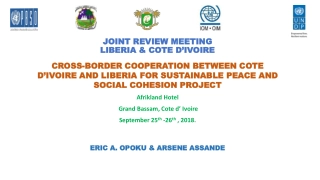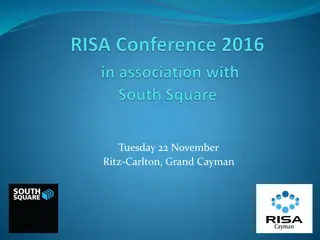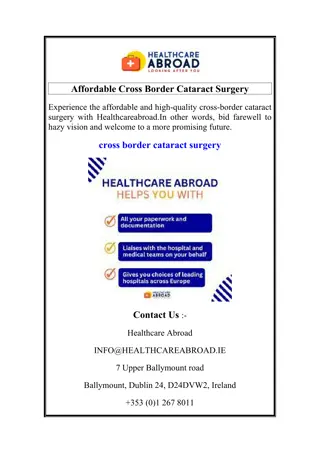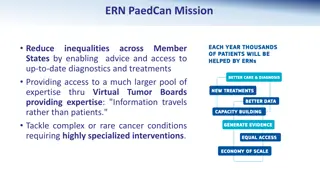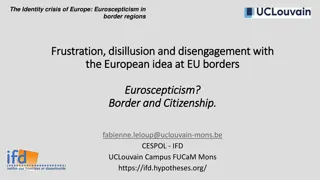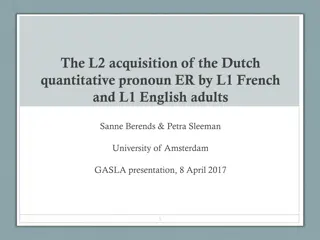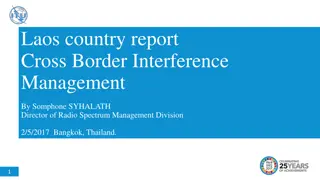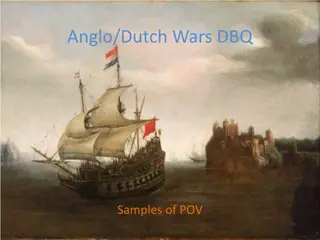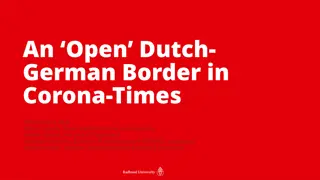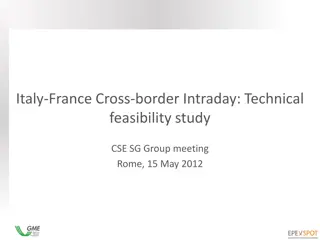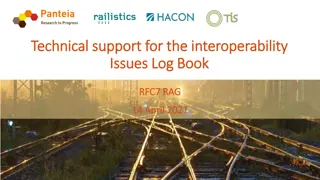Dutch Perspective on Cross-Border Group Insolvencies
This presentation by Prof. Dr. Loes Lennarts explores the Dutch perspective on cross-border group insolvencies, highlighting the lack of specific provisions in Dutch law for group insolvencies and the introduction of the draft Act on Court Confirmation of Extrajudicial Restructuring Plans (WHOA). The WHOA aims to facilitate restructuring plans through out-of-court negotiations and court confirmation, addressing challenges such as substantive consolidation and procedural coordination in group insolvencies.
Download Presentation

Please find below an Image/Link to download the presentation.
The content on the website is provided AS IS for your information and personal use only. It may not be sold, licensed, or shared on other websites without obtaining consent from the author.If you encounter any issues during the download, it is possible that the publisher has removed the file from their server.
You are allowed to download the files provided on this website for personal or commercial use, subject to the condition that they are used lawfully. All files are the property of their respective owners.
The content on the website is provided AS IS for your information and personal use only. It may not be sold, licensed, or shared on other websites without obtaining consent from the author.
E N D
Presentation Transcript
| 1 | 1 Cross Border Group Insolvencies a Dutch Perspective Prof. Dr. Loes Lennarts Universit Luiss Carli, Roma, 11 May 2018
| 2 Group insolvencies in the NL No specific provisions in domestic law Substantive consolidation is a rara avis (only in case of commingling of assets) Procedural coordination (to some extent) is quite common in practice No plans for codification of domestic group insolvency law So I could stop here But I cannot ignore a recent development: The draft Act on Court Confirmation of Extrajudicial Restructuring Plans (WHOA)
| 3 Outline of my talk 1. Introductory remarks about the WHOA (and its relevance for restructuring of groups) 2. Some comments on group insolvencies and the EU Regulation (old and recast) 3. Effects in other EU MS of confirmation judgments rendered under the WHOA?
| 4 The WHOA Bill [To be discussed extensively in lecture tomorrow] Novel type of proceedings, implementing draft Directive 2012/30/EU For information, see https://www.debrauw.com/publication/draft-bill- continuity-companies-act-ii-wcoii/ Aim is restructuring plan (may include debt/equity swap) How? out-of-court negotiations [court may grant (partial) stay and settle preliminary disputes] voting in classes of creditors and shareholders (2/3 (in value) majority) court confirmation (horizontal and vertical cram- down) (best interest test, absolute priority rule)
| 5 WHOA and groups Example: group financed by bonds issued by finance company and guaranteed by parent and other group members In case of insolvency of finance company bondholders will invoke the guarantees Guarantors will have recourse claims against the original debtor This may frustrate rescue attempt WHOA offers two facilities: 1. possibility to include guarantors as (future) creditors in the restructuring plan; 2. extend the restructuring plan to the guarantors as co-debtors
| 6 Art. 369 (7)
| 7 Explanatory memorandum Typically, contracts of suretyship are concluded as part of funding business activities, whereby a third party guarantees a creditor the principal debtor s compliance with an agreement (Article 7:850 DCC). If the principal debtor fails to honour the agreement, the creditor may ask the guarantor to do so. This guarantor will subsequently have a claim against the principal debtor for payment of the security (Article 7:866 DCC) and may have recourse against the principal debtor for the amount concerned, pursuant to Article 6:10 DCC. If the guarantor was subsequently entitled to recover this amount from the debtor, the debtor s financial problems would not be solved by the restructuring plan. Apart from these claims of guarantors, this paragraph also provides for claims from third parties based on other forms of contractual or other security, and claims of fellow debtors against the debtor.
| 8 Art. 370 (2) WHOA
| 9 Explanatory Memorandum:
| 10 Group plan under WHOA? In respect of the entire group ? It seems that all procedural requirements must be met separately for each individual group member included in the plan This includes application of best interests test: what would a creditor have received in case of liquidation of his specific debtor? This means that intra-group claims cannot just be deleted, but they must be included in the calculations So, the WHOA is not a panacea for group restructurings!
| 11 Cross border group insolvencies under Reg. 1346/2000/EC Basic principle: each legal entity has its own COMI (art. 3 (1)) No basis in the Regulation for any cooperation between courts in in different MS ECJ Rastelli: substantive consolidation requires COMI s to be in one MS Same applies to procedural consolidation! Prior to ECJ Eurofood: tendency to argue that sub s head office (and thus COMI) coincides with parent s head office (and COMI), thus enabling procedural consolidation in one MS
| 12 Cross-border group insolvencies in EU Separate COMI s for each entity complicate group restructuring Further complication: secondary proceedings if establishment in other MS Note: these may under Reg. 200/1346/EC only be liquidation type! [More general problem: carve-out for secured assets located in another MS]
| 13 EIR Recast and groups Unchanged: separate main proceedings for each insolvent group member (art. 3 (1)) no substantive consolidation Changed: Secondary proceedings may aim at rescue AND May be synthetic (virtual) (inspiration: Collins & Aikman case (UK)) New (Chapter V): Obligation for different IP s and courts to cooperate and communicate with eachother (art. 56-60) Option to apply for group coordination proceedings (voluntary, opt-out possible) (art. 61-77)
| 14 Opinion on Chapter V EIR (recast) Provisions on Co-Co cooperation are a step forward (but: effect in practice? Language and cultural barriers?) Provisions on group coordination are a typical compromise: very complicated and soft (opt- out (art. 64), no real powers for group coordinator (art. 70) How can this stimulate a speedy process + contribute to deal certainty and value maximization?
| 15 Recently: insolvency of Air Berlin and its sub Niki 15.08.2017: Air Berlin files for insolvency in Germany It has a sub, Niki: registered office in Vienna, Austrian license to operate an airline Most of Niki s flights depart from Berlin airport, where most of its planes are stationed Air Berlin s trustee: Niki s business is controlled from Germany 13.12.2018: German court opened main proceedings in respect of Niki 08.01.2018: judgment annulled on appeal 12.01.2018: main proceedings in respect of Niki opened in Austria 23.01.2018: secondary proceedings in respect of Niki opened in Germany
| 16 Consequences of the fight for jurisdiction over Niki:
| 17 The new restructuring capital of the EU?
| 18 Cross-border perspectives for WHOA? Brexit: where does this leave London as the restructuring capital of the EU? Amsterdam: the new restructuring capital? Interesting development: The Netherlands Commercial Court But what about jurisdiction and recognition of WHOA judgments in other EU Member States?
| 19 WHOA and EIR (recast) Explanatory memorandum is silent on cross- border effects Michael Veder and Jako van Hees (both: Resor and Radboud University): WHOA must be brought within scope of EIR How? Request inclusion in Annex A (see art. 2 (4) EIR (recast) and Christianapol case) But does the WHOA fit into the EIR? See art. 1 (1) EIR and par. 10 Preamble (recast)
| 20 Scope EIR (recast): preamble The scope of this Regulation should extend to proceedings which promote the rescue of economically viable but distressed businesses and which give a second chance to entrepreneurs. It should, in particular, extend to proceedings which provide for restructuring of a debtor at a stage where there is only a likelihood of insolvency, and to proceedings which leave the debtor fully or partially in control of its assets and affairs. It should also extend to proceedings providing for a debt discharge or a debt adjustment in relation to consumers and self- employed persons, for example by reducing the amount to be paid by the debtor or by extending the payment period granted to the debtor. Since such proceedings do not necessarily entail the appointment of an insolvency practitioner, they should be covered by this Regulation if they take place under the control or supervision of a court. In this context, the term control should include situations where the court only intervenes on appeal by a creditor or other interested parties.
| 21 Scope EIR (recast): art. 1 (1) Procedure must be: public ? collective ? based on laws relating to insolvency V AND aim at rescue, debt adjustment reorganisation or liquidation V BY A. (partially) divesting debtor of its assets and appointment of IP X B. subjecting the assets and affairs of the debtor to control/supervision of the court ? C. Granting of temporary stay to facilitate negotiations, provided that .?
| 22 Public? Problem is that WHOA does not provide for publication oft he court s decisions, this requires the attention of the legislator No opening decision (confirmation is final stage of out-of-court process), EIR Recast does not take this into account! So: which decision(s) must be published? In any case: judgment ordering a stay and the confirmation judgment Preferably, all judgments rendered by the court handling the case
| 23 Collective? See art. 2 under (1) EIR (recast) and par. 14 Preamble Restructuring plan under WHOA may be offered to all of the creditors (and shareholders) or a number of them (art. 370) WHOA does not require that plan is offered to a significant part of a debtor s creditors Crucial seems to be that: plan is offered to the (financial) creditors to whom a substantial part of the debts is owed claims of creditors not included in the plan are left untouched
| 24 Control/supervision of the court? See par. 10 preamble as cited on slide 20 In principle, control/supervision of court is limited in WHOA proceedings But: parties involved may ask court to intervene to safeguard their interests
| 25 Granting of a temporary stay etc.? Court has the power to order a (tailor-made) stay It may order suitable measures to protect the creditors in case it has ordered a stay It is likely that a failed process under the WHOA will lead to regular insolvency proceedings
| 26 One more problem EIR requires possibility to appeal against opening judgment, see art. 5 EIR (recast) Full-fledged appeal against the confirmation judgment is not possible (art. 381 (6)) Reason: this will delay the restructuring process + affect deal certainty In this respect the WHOA needs to be revised to bring it under the scope of the EIR
| 27 Conclusion? Bringing the WHOA under the scope of the EIR is feasible (if some sacrifices are made) More in general: this issue needs attention in view of the draft Preventive restructuring framework Directive
| 28 Jurisdiction to apply WHOA under EIR? Group members with COMI in NL: court has jurisdiction to confirm plan encompassing all assets of these entities Group members with COMI in other MS + establishment in NL: court has jurisdiction to confirm plan involving only local assets of these entities These principles preclude the application of art. 370 (2) in respect of co-debtor with COMI in other MS + no establisment in NL!
| 29 Effects of a WHOA plan in other MS? Automatic recognition of judgment opening insolvency proceedings (art. 19 and 20 EIR (recast)) Important limits: Secondary proceedings opened in another MS Carve-out for rights in rem in respect of assets in other MS (at the time of opening (?)) (art. 8 EIR (recast)) - Any stay ordered by WHOA court does not affect these rights - WHOA plan most probably does not affect these rights
| 30 Vi ringrazio per la vostra attenzione


